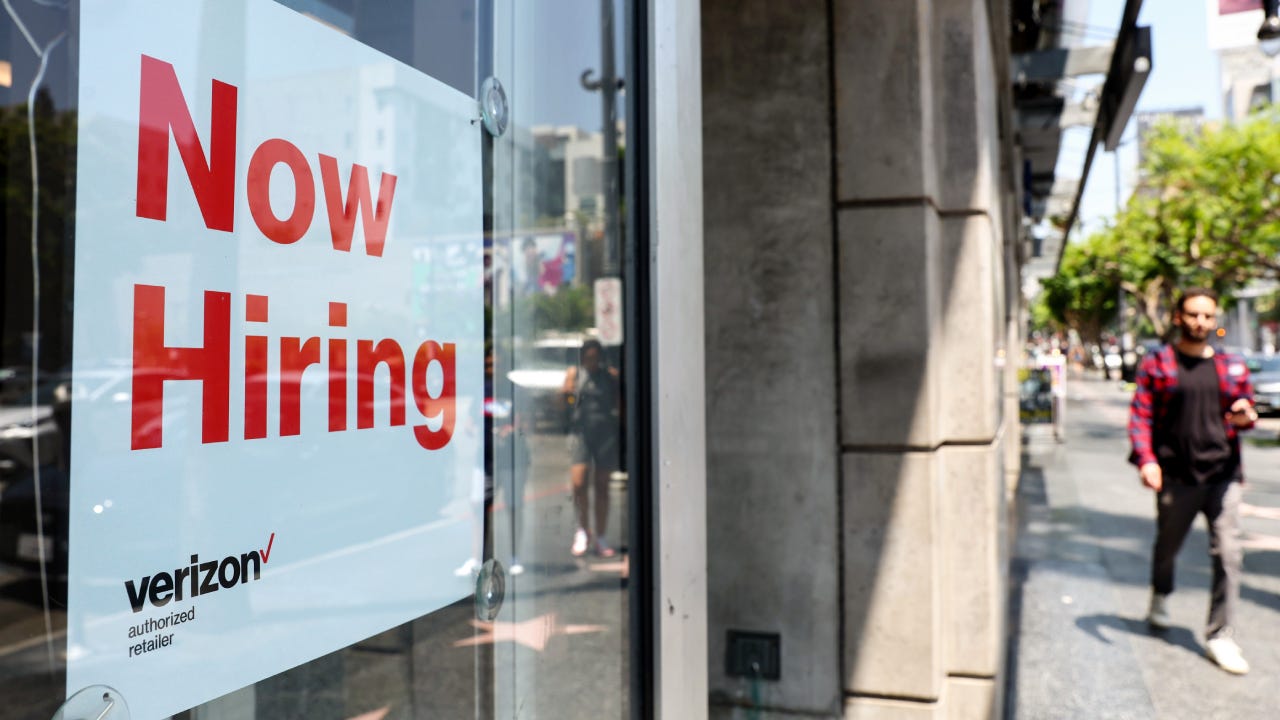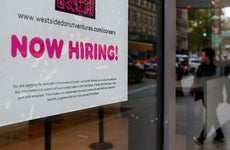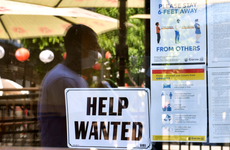Survey: Economists predict jump in unemployment and job losses over next 12 months

The Bankrate promise
At Bankrate we strive to help you make smarter financial decisions. While we adhere to strict , this post may contain references to products from our partners. Here's an explanation for .
The job market has been a powerhouse in the years since the coronavirus pandemic, but a new Bankrate poll suggests that might not last for much longer.
The unemployment rate is predicted to surge to 4.6 percent a year from now, one percentage point higher than its current 3.6 percent level. Employers could also start cutting jobs, the first such call in any previous Bankrate survey of economists. Those could amount to the U.S. economy having 252,000 fewer positions by this time next year, according to the average forecast among economists. The median forecast among economists, however, still called for a modest gain of 60,000 jobs.
A 4.6 percent unemployment rate eclipses the Fed’s 4.5 percent estimate, according to officials’ projections from their March rate-setting meeting. Unemployment hasn’t ever climbed by half a percentage point or more without the U.S. economy being in a recession, though not since the late 1960s has unemployment remained that low during a downturn.
The job market has remained remarkably robust and resilient — so far. With increased caution on the part of many businesses, with credit tightening and with inflation and interest rates still high, the job market faces no shortage of headwinds.— Mark Hamrick, senior economic analyst at Bankrate
Key takeaways:
- Fed seen lifting rates two more times before cutting in 2024
- Inflation to keep decelerating this year as economy slows from high interest rates
- Odds of a recession in 2023 hover at 64% amid bank failures and higher rates
- Economists see jump in unemployment and major job losses over next 12 months
Higher rates, bank failures could bring an end to the booming post-pandemic job market
Jobseekers have been reaping the benefits of the most robust labor market in more than half a century. A record number of job openings coupled with an estimated 3.5 million workers gave workers the power to negotiate for higher pay and hunt for better positions. Employers lifted wages by the fastest pace in records dating back two decades, according to the Department of Labor.
Even against the Fed’s fastest rate hikes in 40 years and growing recession odds, workers were still hungry to job hunt. More than half (or 56 percent) of Americans in the labor force said in a separate Bankrate survey from April they were planning to hunt for a new position in the next year, up from 51 percent in 2022.
But the booming labor market brought inflation along with it, calling into question whether workers were truly getting ahead. Wages in 2022 jumped 5.3 percent from a year ago, while consumer prices soared at a faster 8 percent pace, according to data from the Department of Labor.
Even as the largest share of workers in any prior survey from Bankrate reported seeing a pay raise in 2022, only 2 in 5 (or 39 percent) who scored higher pay said their income had kept pace or risen faster than consumer prices.
The labor market has been facing some of its own supply bottlenecks, and Federal Reserve Chair Jerome Powell says the tight labor market may have to take some of the blame for today’s rapid inflation burst. Employers have close to 1.7 job openings per every unemployed worker, a near-record mismatch that’s resulting in businesses having to lift wages to lure more applicants. Businesses often pass along those higher wages to consumers by increasing prices.
The Fed’s rate hikes cool the labor market by design, making it harder for companies to access the capital required to fund hiring or investments. A slump in consumer spending may rob them of even more growth to keep expanding.
Even the recent failure of Silicon Valley Bank and Signature Bank poses threats for the historically strong job market, as banks slow lending.
“Reality is finally settling into the corporate world and the desire to hire, hire and hire is fading,” says Joel Naroff, founder of Naroff Economics. “The first indication should be a sharp fall in job openings as layoffs expand and hiring freezes and cuts take hold. Labor market shortages will soon give way to rising layoffs and a softening labor market as rising interest rates, tighter bank credit and elevated inflation eventually smother consumer and business demand.”
While the average forecast among economists foreshadowed that job cuts could be in store for the year ahead, 65 percent in Bankrate’s poll still expect some level of job growth.
Yet, even the most optimistic of economists’ forecasts reflect a sharp slowdown. Job growth over the past year has averaged 362,000 jobs per month, more than two times faster than the pre-pandemic pace from 2019. The highest forecast, however, penciled in average monthly job growth of 200,000 over the next 12 months.
The worst of the forecasts, meanwhile, one economist penciled in job cuts worth 692,000 each month over the next 12 months.
“These job losses would largely be driven by tightening credit conditions and higher borrowing rates, as well as the weakened desire of consumers to spend, given their increasing concerns regarding the potential onset of a recession,” says Nayantara Hensel, chief economist at Seaborne Defense, who penciled in the lowest forecast.
Hear from the experts
It may not yet be evident, but the labor market is cooling. While the economy added a solid 311,000 jobs in February, the unemployment rate pushed higher to 3.6 percent, monthly wage momentum softened and the number of hours worked fell back. Labor market tightness will remain a feature of this business cycle — given business executives’ reluctance to let go of their valuable and prized talent pool and a shrinking talent pool – but we continue to anticipate reduced hiring, strategic resizing decisions and wage growth compression. We see the economy losing around 600,000 jobs in the coming quarters with the unemployment rate rising toward 4.5% by year-end.
— Gregory Daco, chief economist at EY
There’s an expression, ‘When the Fed taps on the brakes, somebody goes through the windshield.’ While the labor market has shown resiliency and strength in the face of restrictive monetary policy, labor market cracks are beginning to appear in the form of layoffs. It will be increasingly difficult to continue to fight inflation so intensely without broader impacts on employment. As excess consumer savings cushions slowly deflate, consumers should begin to pull back on spending, which may slow labor demand.
— Odeta Kushi, deputy chief economist at First American Financial Corp.
There are too many out of the labor force — three million more than pre-COVID days. If we can get more to re-enter the market, then the unemployment rate may rise at the same time of job additions. But it will be great news in regards to inflation, as wage pressure will lessen and because more goods and services will be provided — hence lessening consumer price inflation.
— Lawrence Yun, chief economist at the National Association of Realtors
-
The First-Quarter 2022 Bankrate Economic Indicator Survey of economists was conducted March 23-30. Survey requests were emailed to economists nationwide, and responses were submitted voluntarily online. Responding were: Odeta Kushi, deputy chief economist, First American Financial Corporation; Yelena Maleyev, economist, KPMG; Scott Anderson, chief economist, Bank of the West; Nayantara Hensel, Ph.D., chief economist, Seaborne Defense; Joel L. Naroff, founder, Naroff Economics; Mike Fratantoni, chief economist, Mortgage Bankers Association; Robert Frick, corporate economist, Navy Federal Credit Union; John E. Silvia, CEO and founder, Dynamic Economic Strategy; Dante DeAntonio, director of economic research, Moody’s Analytics; Bernard Markstein, president and chief economist, Markstein Advisors; Lawrence Yun, chief economist, National Association of Realtors; Robert Brusca, chief economist, Fact and Opinion Economics; Bill Dunkelberg, chief economist, NFIB; Gregory Daco, chief economist, EY; Lindsey Piegza, Ph.D., chief economist, Stifel; Eugenio J. Alemán, Ph.D., chief economist, Raymond James Financial; and Mike Englund, chief economist, Action Economics.
Related Articles

Survey: Economists see slower hiring and more unemployment in 2023

Survey: Employers to create half as many jobs by March 2025, unemployment to top 4%


Survey: Economists see unemployment holding above pre-pandemic levels a year from now